Order of matrix in Discrete mathematicsWe can show the number of rows and columns of any matrix with the help of order of that matrix. A matrix can be described as an array of elements that are arranged in the form of rows and columns. With the help of order of matrix, we will be able to get the count of rows and columns in the given matrix. The order of matrix is also known as the dimension of matrix. It is expressed in the form of a number of rows multiplied by the number of columns, and we can read the order of matrix as the number of rows by the number of columns. When we multiply the number of rows and columns of any matrix, then we will be able to get the number of elements of that matrix. Further, we can get the types of matrix with the help order of the matrix. It can also provide us the total number of elements that are present in any matrix. The elements of the matrix are arranged in the form of m rows and n columns. We will be able to decide whether the particular arithmetic operation will be performed on the two matrices with the help of order of the matrix. It is used to know about the different types of matrices. We can also learn about the different types of arithmetic operations that will be performed on these matrices. In this section, we will learn about the order of matrix, types of matrices on the basis of order of the matrix, Different matrix operations, examples of order of a matrix, and many more things. What is Order of matrixWe will get the dimension of a matrix with the help of order of the matrix. The dimension of matrix is used to show the number of rows and a number of columns in the matrix. The symbol Am*n is used to show the order of matrix. Where m is used to indicate the number of rows and n is used to indicate the number of columns in matrix A. In any matrix, we will also get the number of elements with the help of multiplying the result of order of the matrix (m*n). 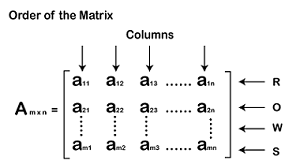
If there is any order of a matrix, then the first number of the order will always be used to indicate the rows, and the second number of the order will be used to indicate the columns. In this image, we can see that the number of rows is m, and the number of columns is n. Examples of matrices on the basis of orderHere we will show some matrices with different orders and the total number of elements in the given matrix, which are described as follows: Example 1: In this example, we will show a matrix with an order 1*1, i.e., A = [-6] In this matrix, we can see that there is 1 row and 1 column in matrix A. We can read this matrix as one by one matrix. That's why matrix A will be known as the matrix of order 1*1. In the above matrix A, the total number of elements = 1*1 = 1. Example 2: In this example, we will show a matrix with an order 1*3, which is described as follows: B = [2 6 7] In this matrix, we can see that there are 1 row and 3 columns in matrix B. We can read this matrix as one by three matrix. That's why matrix B will be known as the matrix of order 1*3. In the above matrix B, the total number of elements = 1*3 = 3. Example 3: In this example, we will show a matrix with an order 2*2, which is described as follows: 
In this matrix, we can see that there are 2 rows and 2 columns in matrix C. That's why matrix C will be known as the matrix of order 2*2. We can read this matrix as two by two matrix. We can simply call it a matrix of order 2. In the above matrix C, the total number of elements = 2*2 = 4. Example 4: In this example, we will show a matrix with an order 3*4, which is described as follows: 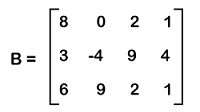
In this matrix, we can see that there are 3 rows and 4 columns in matrix B. We can read this matrix as three by four matrix. That's why matrix B will be known as the matrix of order 3*4. In the above matrix B, the total number of elements = 3*4 = 12. Types of matrices on the basis of order of matrixWe can get the dimensions of the matrix with the help of order of the matrix. There are different types of matrices, and we can find the order of these matrices. Some different types of matrices with their orders are described as follows: Order of Row matrix: A matrix will be known as the row matrix if it contains one row and more than one number of columns. So we can say that the order of this matrix will be in the form 1*n.
A1*n = [a1 a2& a3 … an]
Order of Column matrix: A column matrix is used to contain one column and more than one number of rows. So we can say that the order of this matrix will be in the form n*1. 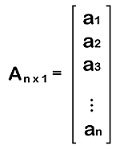
Order of Square matrix: We can call the matrix a square matrix if there is the same number of rows and columns. So we can say that the order of this matrix will be in the form n*n. In the following image, there are 3 number of rows and 3 number of columns in the matrix. Hence this matrix is a square matrix. 
Order of Rectangular matrix: We can call the matrix a rectangular matrix if there are not the same number of rows and columns. So we can say that the order of this matrix will be in the form m*n. In the following image, there are 2 number of rows and 3 number of columns in the matrix. Hence this matrix is a rectangular matrix. 
Order of Transpose matrix: A matrix will be known as the transpose matrix if we interchange the elements of rows into columns and, similarly, the elements of columns into rows. If we have a matrix with an order m*n, then order of its transpose matrix will be n*m. In the below image, we have a matrix that contains 2 rows and 3 columns. So the transpose of the following matrix will contain the 3 number of rows and 2 number of columns. Hence the order of this transpose matrix is 3*2. 
Order of matrix for Different matrix operationsOn the basis of the types of matrices, the order of the matrices depends. There are a lot of operations of matrices that are also based on the order of matrix. Now we will see some operations on matrices, and we will perform them on the basis of order of the matrix. These operations are described as follows: Addition and Subtraction of matrices: If we want to perform the addition or subtraction operation on two matrices, then both the matrices must have the same number of order. That means the number of rows and columns in these matrices must be similar to each other. Now we will use an example to understand the concept of matrix addition: 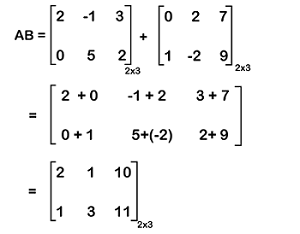
In this example, we can see that matrix A contains an order 2*3, and matrix B contains an order 2*3. That means both matrices have the same order. Se we will add the corresponding elements of matrix A and matrix B and get a matrix as a result with the same order 2*3. Multiplication of matrices: In case of order of matrices, there is a special condition that has to be fulfilled while multiplying the matrices. According to that condition, the number of columns in 1st matrix and the number of rows in 2nd matrix must be similar to each other. The order of a resultant matrix of matrix multiplication must have the same number of rows in 1st matrix and the same number of columns in 2nd matrix. The example of multiplication of matrices is described as follows: 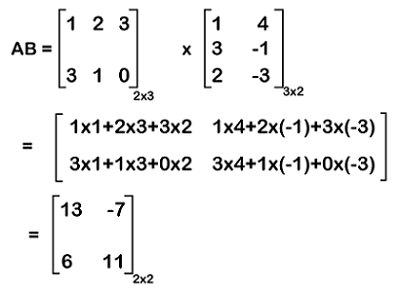
In this example, we have two matrices in which the number of columns in the 1st matrix and the number of rows in the 2nd matrix has similar to each other, i.e., 3. With the help of rules of matrix multiplication, we will get the resultant matrix as an order 2*2 (because the number of rows in 1st matrix is 2 and the number of columns in the 2nd matrix is 2). Important notes on Order of matrixThere are some points that we should know when we learn about the order of matrix, which is described as follows:
Examples of Order of matrixThere are various examples of order of the matrix, and some of them are described as follows: Example 1: In this example, we have a matrix with an order 4*3. Now we have to determine the order of matrix with which we can multiply this matrix. We have to also find the order of a resultant matrix after multiplication. Solution: As we know that we have a matrix with an order 4*3. So we will show this matrix as A4*3. We will also consider one more matrix B, and we will multiply this matrix by matrix A. If we want to perform matrix multiplication on two matrices, then the number of columns in the 1st matrix and the number of rows in the 2nd matrix must be similar to each other. In matrix A, we have 3 number of columns. So we will have 3 number of rows in matrix B. Suppose the order of matrix B is 3*2. Then A4*3 * B3*2 = C4*2 As we can see, we get C as a result of the multiplication of matrices A and B. The matrix C has the number of rows of the 1st matrix and the number of columns of the 2nd matrix. Answer: Therefore, the second matrix can have an order 3*2, and the resultant matrix can have an order 4*2. Example 2: In this example, we have two matrices with an order 2*4 and 4*3. Here we have to determine the order of matrix, which we get by multiplication of these matrices. Solution: As we know, the two matrices are 2*4 and 4*3. So we will assume these matrices as A and B. The first condition of matrix multiplication is satisfied by these matrices, which say that the number of columns of the 1st matrix and the number of rows of the 2nd matrix are similar to each other. Further, the order of a resultant matrix must have the number of rows of the 1st matrix and the number of columns of the 2nd matrix. Hence the resultant matrix will have the order 2*3. The multiplication of both matrices with their order is described as follows: A2*4 * B4*3 = C2*3 Answer: Therefore, the resultant matrix will have the order 2*3. Example 3: In this example, we have two matrices, A and B, where A contains an order 3*4 and B contains an order 4*3. Now we have to check if it is possible to add all these matrices. Solution: As we know that we can add two matrices if and only if the order of these is the same. But the order of matrix A is 3*4, and the order of matrix B is 4*3, which are not equal to each other. So it is not possible to add matrices A and B. Answer: A+B is not possible.
Next TopicHermitian matrix in Discrete mathematics
|
 For Videos Join Our Youtube Channel: Join Now
For Videos Join Our Youtube Channel: Join Now
Feedback
- Send your Feedback to [email protected]
Help Others, Please Share









